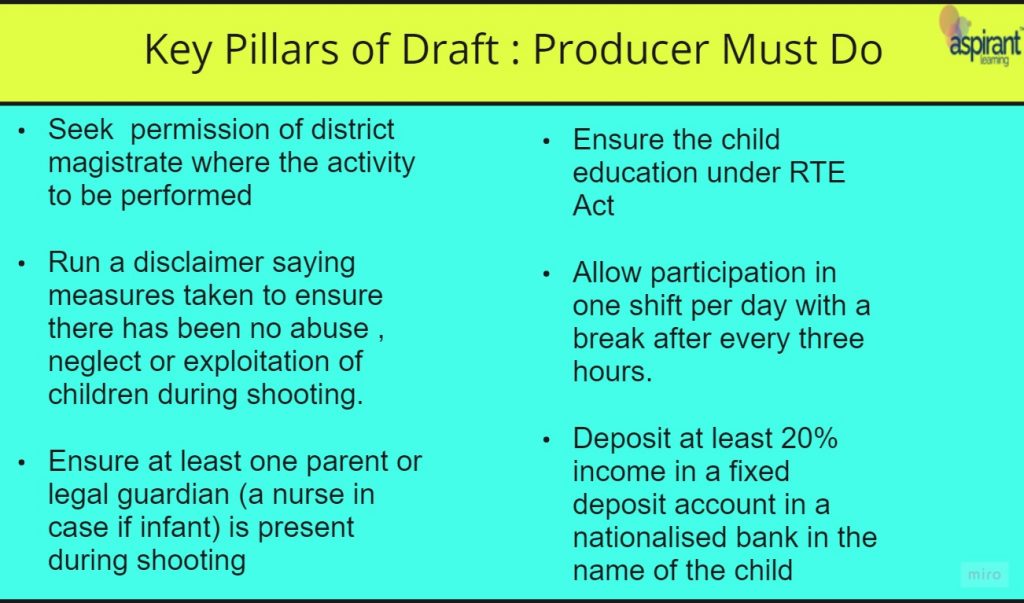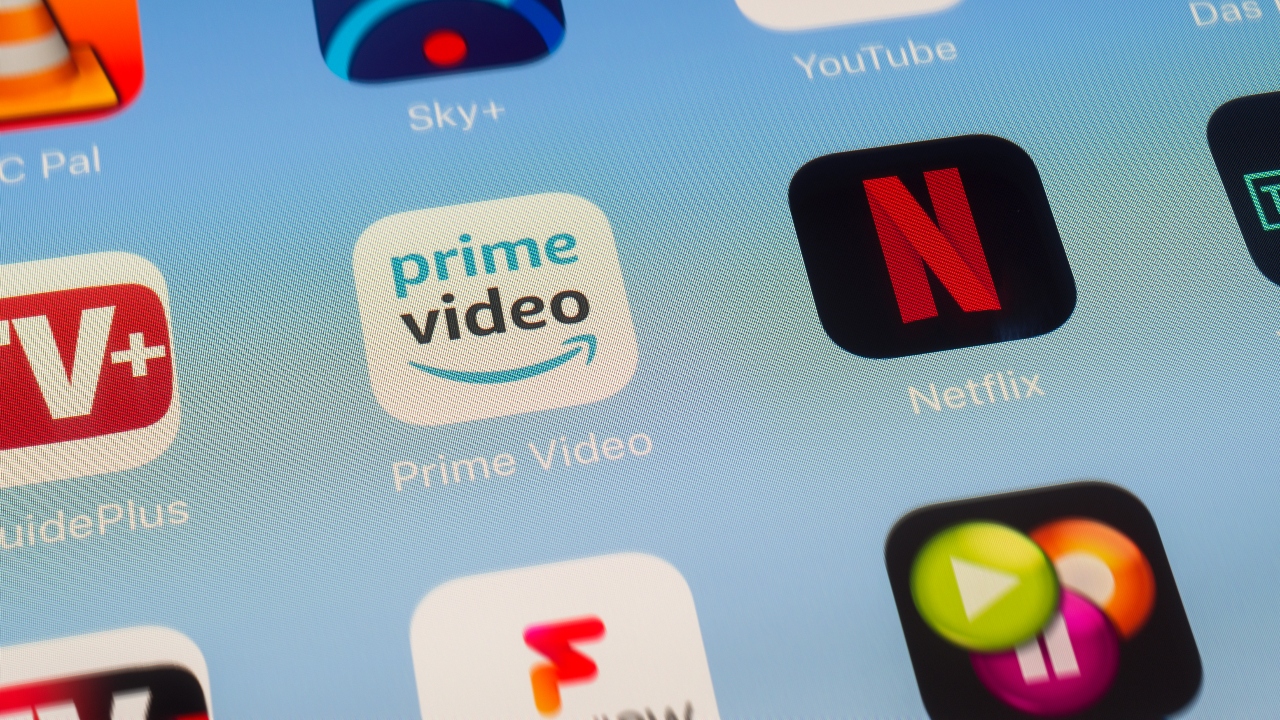News Highlights
The National Commission for the Protection of Child Rights (NCPCR) has today published draft guidelines for OTT platform acting children that facilitate child protection within the entertainment industry.
Draft Guidelines for OTT Platform Acting Children
- Draft increases the scope of the “Guidelines to Regulate Child Participation in the Entertainment Industry” were issued by the Commission in 2011
- The new draft aims to cover social media and OTT platforms for the first time.
- More Control
- The draft included stringent penal provisions for violating the guidelines, including imprisonment, and has mandated that child artists and children being used in entertainment need to be registered with District Magistrates.
- Parents, who are using children to make money, have to be held accountable.
- There are different Acts protecting children — the provisions of these Acts have now been included in the guidelines.
- Provisions under the Juvenile Justice Act, 2015, Child Labour Amendment Act, 2016
- Protection of Children from Sexual Offences Act, 2012,
- Information Technology (Intermediary Guidelines and Digital Media Ethics Code) Rules, 2021.
- Major Aim of Move
- Aim to ensure a healthy work environment for them with minimal physical and psychological stress
Need of the Draft Guidelines for OTT Platform Acting Children
- In the absence of any monitoring mechanism, the children in the industry are at grave risk of exploitation because they lack the legal right to the earnings they generate, or safe working conditions and adequate protections via labour laws, etc.
- Participating in an adult-oriented industry, children are often exposed to unsuitable, anxiety inducing, and at times, dangerous operational hazards and situations
- Apart from the industry-specific risks, the children are also susceptible to a plethora of other crimes against children such as sexual exploitation, child trafficking, bonded labour.
Area of Coverage
- The scope of the new guidelines will cover TV programmes , reality shows, serials, news and informative media, movies, content on OTT platforms, content on social media, performing arts, advertising and any other kind of involvement of children in commercial entertainment activities.
- They will be applicable to “any relevant institution comprising companies, organizations, or individuals involved in the production and broadcasting of such material along with the central and state government concerned”.
Pre Steps Before Shooting
- Producers will also have to run a disclaimer saying measures were taken to ensure there has been no abuse, neglect or exploitation of children during the entire process of the shooting.
Steps to Protect Children
- Prohibition – The guidelines prohibit children being cast in roles or situations that are inappropriate; consideration has to be given to the child’s age, maturity, emotional or psychological development and sensitivity; a child cannot be exposed to ridicule, insult or discouragement, harsh comments or any behaviour that could affect his/her emotional health and children cannot be shown imbibing alcohol, smoking or using any other substance or shown to be indulging in any sort of antisocial activity and delinquent behaviour. No child can be engaged in any situation involving nudity.
- Parents – At least one parent or legal guardian or a known person has to be present during a shoot, and for infants a registered nurse needs to be present along with the parent or legal guardian.
- Child Age – A minor, especially below the age of six years, shall not be exposed to harmful lighting, irritating or contaminated cosmetics
- Medical Condition – Every person involved in the production who may be in contact with children will have to submit a medical fitness certificate ensuring that they are not carrying obvious contagious disease and police verification of the staff also needs to be carried out.
- Education and Basic Facilities – The producer also needs to ensure the child’s education under the RTE Act, to ensure no discontinuity from school or lessons as well as adequate and nutritious food, water to the children during the process of production and medical facilities.
- Working Condition – A child shall only participate in one shift per day, with a break after every three hours.
- Financial Inclusion – At least 20 percent of the income earned by the child shall be directly deposited in a fixed deposit account in a nationalized bank in the name of the child
- Legal Backing – Content created by the child or his family/guardian shall be treated as children working in a family enterprise as provided under Section 3(2)(a) of the Child Labour and Adolescent Labour Act, 1986

| Do You Know? OTT Platforms – OTT Platforms, also known as the Over-the-top platform, are web-based services offering video and audio streaming content |
National Commission for the Protection of Child Rights (NCPCR)
- Legal Status – It is a statutory body established under the Commission for Protection of Child Rights (CPCR) Act, 2005.
- Ministry – Ministry of Women and Child Development
- Aim – It aims to make sure that all laws, policies, programmes, and administrative mechanisms are in line with the viewpoint on children’s rights that is reflected in both the Indian Constitution and the UN Convention on the Rights of the Child.
- Composition – This commission has a chairperson and six members of which at least two should be women
- Appointment – Appointment by Centre Government for 3 years
- Tenure
- The maximum age to serve in commission is 65 years for Chairman and 60 years for members.
- Function
- Examine and assess the safeguards offered to protect children’s rights, and suggest actions to ensure their efficient implementation.
- Investigate instances of child rights violations and urge the start of legal action.
- Examine every factor that interferes with children’s ability to enjoy their rights when there has been terrorism, intergroup conflict, rioting, natural disaster, domestic violence, HIV/AIDS, trafficking, maltreatment, torture, and exploitation, pornography, or prostitution, and suggest appropriate corrective actions.
- Look into issues with kids who need extra attention and protection, such as kids in need, marginalized and underprivileged kids, kids without families, and kids of convicts, and suggest the best corrective actions.
- Study international treaties and other legal documents. Periodically examine current child rights policies, program, and other initiatives. Make recommendations for their successful implementation in the best interests of children.
- Conduct and encourage research in the area of children’s rights.
- By using publications, the media, seminars, and other accessible tools, increase knowledge of child rights across diverse societal groups and raise awareness of the measures available to defend these rights.
- Inspect or arrange for an inspection to take place at any institution or place of residence for children that is under the supervision of the Central Government, a State Government, or another authority.
Pic Courtesy : Deccan Herald
Source – Indian Express



